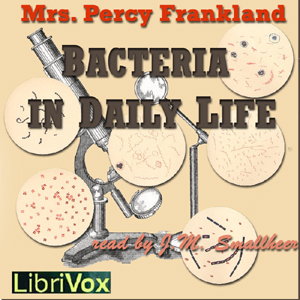Bacteria in Daily Life
The author provides a fascinating look at the emerging science of bacteriology at the start of the twentieth century including early progress in understanding and preventing diseases such as tuberculosis and diphtheria. The book also includes chapters on the spread of disease through close contact with infected persons as well as from contaminated drinking water and milk. Water purification methods as well as the stability of various disease-causing organisms to extremes of heat and cold is discussed. The final chapter includes a very interesting discussion of the development of anti-venoms for the treatment of snake bite and related poisons. (summary by J. M. Smallheer)
NY Times Book Review April 4, 1903:
Mrs. Frankland's book is a popular presentation in lively style of what the ordinary unscientific person should know of bacteria as they immediately affect daily life. She has managed to invest her subject with astonishing interest and to produce a work that any sane man or woman can read without weariness. Beginning with Latour's discovery of the fact that yeasty fermentation is due to minute vegetable growths, she traces rapidly the development of bacteriological knowledge through the age of Victoria. As a matter of fact the announcement of Latour's discovery and the accession of Victoria to the throne came very close together in the same year.
Following this historical disquisition is a presentation in successive chapters of these subjects: "What We Breathe," "Sunshine and Life," "Bacteriology and Water," "Milk Dangers and Remedies," "Bacteria and Ice," and "Poisons and Their Prevention." The most practical chapter for the householder is that on milk. The most novel and interesting is perhaps that on poisons and their prevention. This chapter deals largely with snake venom, and its revelations are marvelous. Next in practical value to the chapter on milk is that on water. It is satisfactory to find the author assuming that boiled water may be regarded as sterile. Interesting and important also is the fact that an analysis of many natural mineral springs shows them to be nearly free from bacteria. The resistance of bacteria to cold is one of the most striking things set forth in the book, and the destructive power of sunshine is another.
Genre(s): Life Sciences
Language: English
Keyword(s): science (223), tuberculosis (6), bacteria (4), Pasteur (3), microbiology (3), bacteriology (2), microorganisms (2), sewage treatment (2), antitoxin (2), diptheria (1) ... [Show full list]
| Section | Chapter | Reader | Time |
|---|---|---|---|
| Play 01 | Bacteriology in the Victorian Era | J. M. Smallheer |
00:25:04 |
| Play 02 | Bacteriology in the Victorian Era, con't. | J. M. Smallheer |
00:18:53 |
| Play 03 | What We Breathe | J. M. Smallheer |
00:24:34 |
| Play 04 | What We Breathe, con't. | J. M. Smallheer |
00:16:18 |
| Play 05 | Sunshine and Life | J. M. Smallheer |
00:23:07 |
| Play 06 | Sunshine and Life, con't. | J. M. Smallheer |
00:12:03 |
| Play 07 | Bacteriology and Water | J. M. Smallheer |
00:32:37 |
| Play 08 | Milk Dangers and Remedies | J. M. Smallheer |
00:22:53 |
| Play 09 | Milk Dangers and Remedies, con't. | J. M. Smallheer |
00:20:22 |
| Play 10 | Bacteria and Ice | J. M. Smallheer |
00:24:47 |
| Play 11 | Some Poisons and Their Prevention | J. M. Smallheer |
00:29:21 |
| Play 12 | Some Poisons and Their Prevention, con't. | J. M. Smallheer |
00:36:12 |
